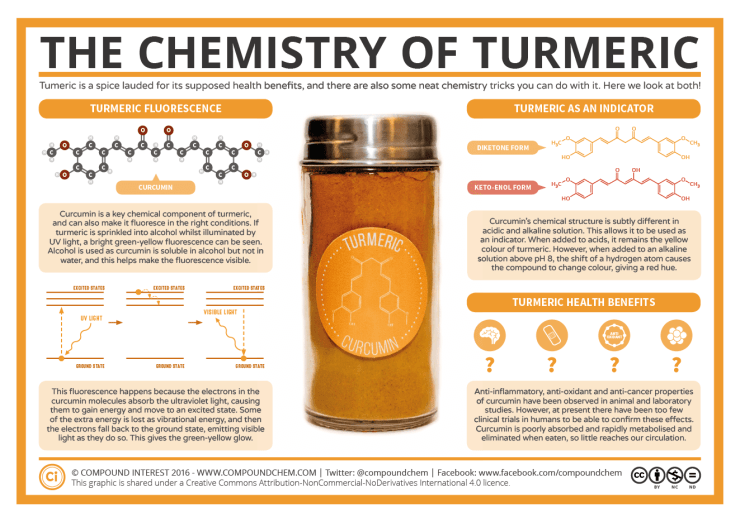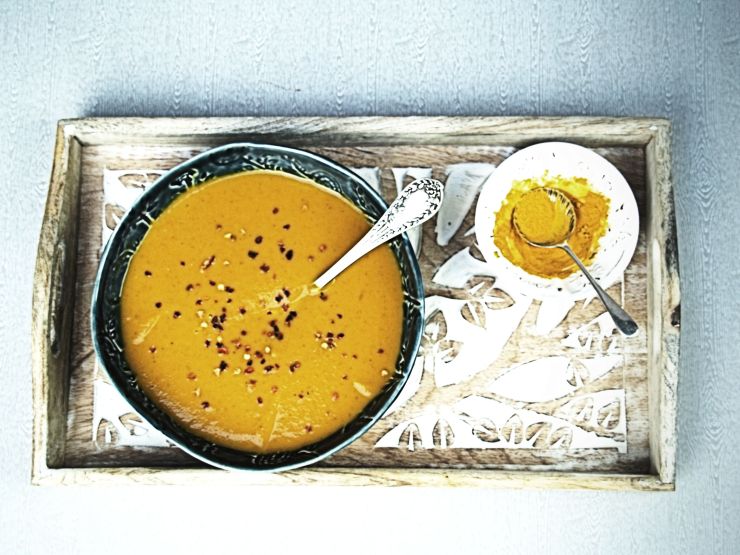
Turmeric is a wonderful ingredient to add to a curry – it has also been exalted as a wonder food with lots of great benefits for health. Some of the more pervasive anecdotes with regards to turmerics ‘heath benefits’ are antioxidant, anti-inflammatory and anti-cancer effects and benefits for digestive health and IBS.
I have always had a bit of a problem with the anti-oxidant hypothesis in health, as an ex-polymer chemist, I was very experienced in protecting polymer products such as paints and adhesives from the effects of oxidation and environmental free radical degradation. This was not always easy to achieve – even the in simplest of formulations.
These free radical reactions do occur in our bodies – at a base level we are a very complex mix of chemical reactions and our bodies contain polymers. Turmeric is a polyphenol, and polyphenols do show anti-oxidant properties. With anti-oxidant protection, as a chemical reaction, one factor needs to be fulfilled – the anti-oxidant has to be situated at the site where the free radical reactions occur to be able to mop them up. Therefore any research involving turmeric in Petri dishes to observe it’s anti-oxidant (and anti-inflammatory or anti-cancer effects), or by feeding animals unsustainably large amounts may be very interesting, but far from proving it to be an effective anti-oxidant in our body. There is a problem with turmeric – it is very poorly absorbed in the digestive tract, it has poor solubility – therefore it would be difficult to transport it to the site of reaction. If the anti-oxidant cannot physically be transported to the site of free radical reaction, then it is clearly not possible for it to react! Until this problem is solved it is perhaps an entirely useless medical treatment, and of course, it needs to be studied in humans as a treatment, with randomized controlled trials and ultimately a systematic review. These problems can possibly be solved – by utilizing chemistry.
But…but…turmeric is ‘natural’, is the response, so therefore it is surely better for us than all those ‘chemicals’ in medicines? If you are going to use the anti-oxidant theory for the promotion of ‘alternative’ natural care, then you are buying into chemistry by using this as your argument. Spoiler alert – curcumin, the active compound in turmeric, is a chemical – see the infographic above. If it was effective it would be called a medicine, which may be possible in the future with lot’s more health research – but certainly, we are a very long way from this now. One research paper proposed turmeric as a jack-of-all-trades, in other words ‘useful’ for numerous health areas, which concomitantly also means master of none, an insightful figure of speech here, perhaps.
For digestive complaints, turmeric has a long history of use in Ayurvedic medicine as a compound which can be useful for indigestion, but with little strong evidence for effective use in either IBS or indigestion – just tantalizing pre-clinical trials and uncontrolled studies.
Past history has taught us that medicines are often derived from naturally occurring pharmacological plants, so research of turmeric should certainly continue – but we really shouldn’t be tempted to jump the gun with promoting turmerics alleged health effects, this is disingenuous.
So does turmeric have any benefits at all? Of course! Turmeric is low fodmap as a spice and can be used to flavour low fodmap recipes for people who have irritable bowel syndrome and imparts these foods with a very vibrant colour. If you are wanting a January ‘health kick’ from turmeric, or use it to ‘cure’ your IBS, then think again, but enjoying a great, warming, vibrant low fodmap meal made from turmeric, either low fodmap curry, or the low fodmap soup recipe below, in the depth of winter, is surely a sublime use of this wonderful spice?
Carrot, ginger and turmeric soup
Ingredients
500g carrots
1 tablespoon of oil
1 teaspoon of Moroccan spice (Fodify)
1 teaspoon of ginger
2 teaspoons of turmeric
1500mls water
seasoning to taste
Method
Peel and chop the carrots
Fry the spices in oil to release the flavour
Add the water and carrots to the spices
Cook till the carrots are soft, then blend with a hand blender
Season
Serves 3-4
https://www.nhs.uk/news/cancer/curry-spice-kills-cancer-cells/
https://www.nhs.uk/news/food-and-diet/spice-for-mice/
https://www.nhs.uk/news/food-and-diet/could-curry-spice-boost-brain-cell-repair/
https://link.springer.com/article/10.1007%2Fs11894-016-0494-0





Thank you, Jules, for your take on Turmeric some insight into the differences between in vitro and in vivo concepts. I think far too many people see the human body as a test tube without realising the ability for multicellular organisms as evolved as humans to compartmentalise reactions. Each of our cells should be considered multiple test tubes which means we are trillions of test tubes rather than just one where a simple exposure to a chemical may have an interesting action.
Thanks Gary – and happy new year to you! Yep I think turmeric is very interesting – but much more research needed! 🤔
Turmeric has great flavour and some potential. It’s even advertised on our TV screens in Australia as a potential cure for all sorts of ailments. I’m sure people are buying it convinced it is helping them. I look forward to the results of clinical trials.
Thanks for this balanced review of turmeric. It’s hard to find this kind of comment among the generally unscientific internet hype.
Hi Lynn thanks for your comment – for the moment it is just best to enjoy turmeric for what it is – a great spice!
Very well stated. I love posts from scientists explaining their work!
Thanks 😊
What an excellent post on Turmeric. Sound science and perfect sense.
Thanks Nick!